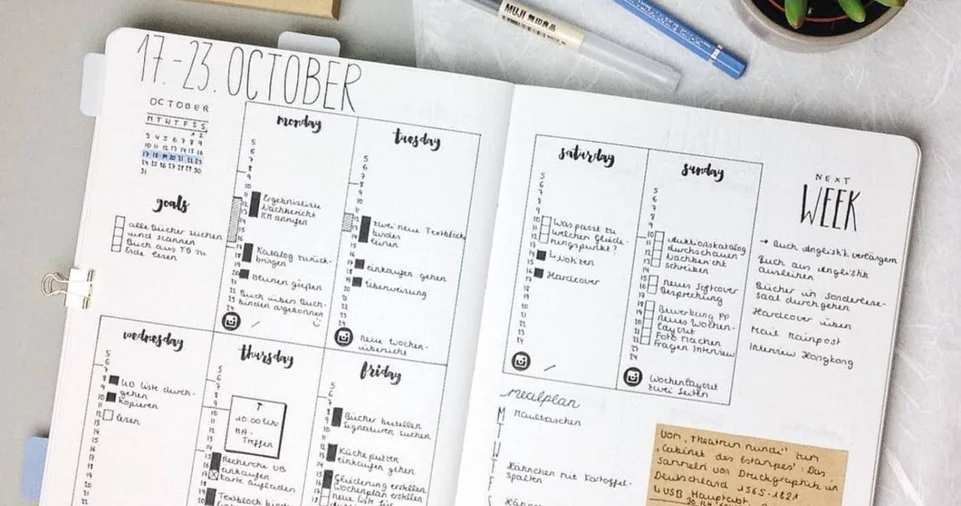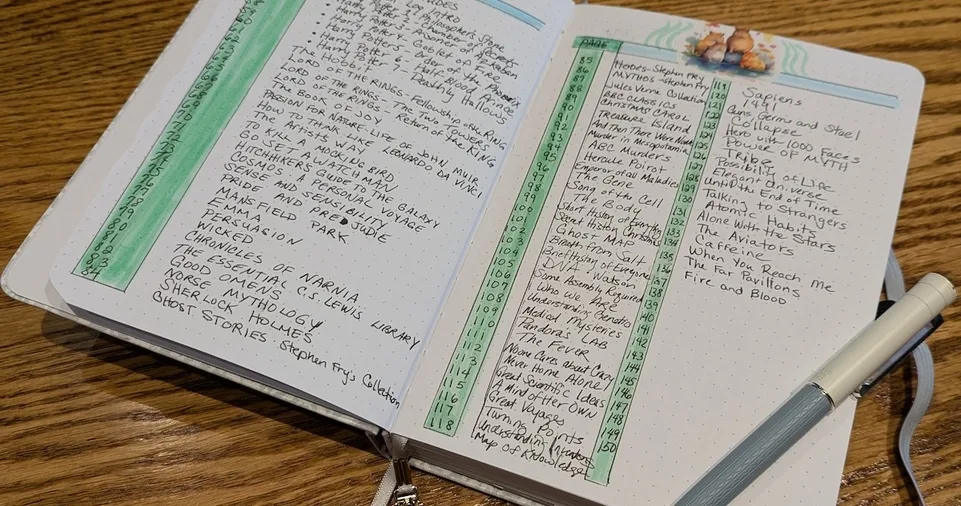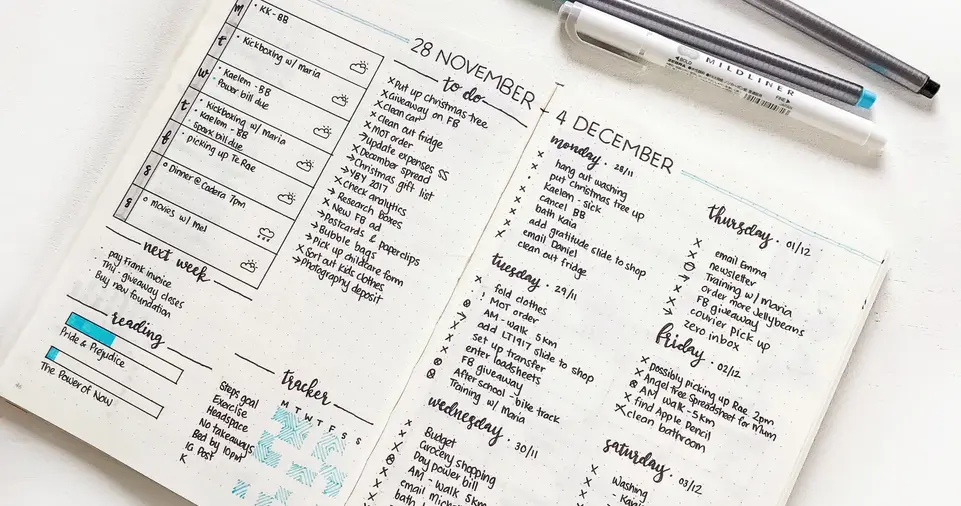Reading is one of the most enriching activities, yet it can be hard to keep track of your progress without a system in place.
Whether you’re a bookworm who wants to document every title you’ve devoured or someone aiming to start reading more regularly, keeping a record of your reading goals can help boost motivation and keep you on track.
One of the best ways to do this is through a Bullet Journal.
The Bullet Journal (BuJo) method is an adaptable, customizable system that helps you organize your goals, tasks, and reflections in a way that suits your personal style.
For reading enthusiasts, it can be an excellent tool to track books, set realistic reading goals, and visually see your progress.
It turns the mundane task of tracking your reading into a creative and enjoyable activity.
This guide will explore how to track your reading goals with a Bullet Journal, providing you with tips, layouts, and strategies to make your reading journey organized and inspiring.
From setting clear reading goals to incorporating fun elements into your pages, you’ll find a step-by-step process to help you meet your literary aspirations.
Setting Clear Reading Goals in Your Bullet Journal
Define Your Reading Objectives
The first step in tracking your reading goals is to define what you want to achieve. Be specific about your aspirations for reading.
Do you want to read a certain number of books by the end of the year? Are you looking to explore new genres or authors? Defining your goals clearly can help you create a roadmap for success.
Total Books Goal
Start with a total books goal. For instance, “Read 30 books in 2024.” This is a straightforward goal that is easy to track and gives you something tangible to focus on.
You can break this down into monthly or weekly targets depending on your schedule and reading speed.
If 30 books seem overwhelming, set a more realistic goal such as “Read 12 books in 6 months” or “Read 5 books by the end of summer.”
Genre-Specific Goals
Another approach is to aim for genre-specific reading goals.
For example, you might want to read a mix of fiction and non-fiction, or perhaps you want to focus on one genre, like fantasy or mystery.
You can even set specific goals such as “Read 5 classic novels” or “Read 3 memoirs.”
This approach will expand your reading horizons and prevent you from sticking to the same genre all year.
Quality Over Quantity
It’s important to remember that reading goals aren’t only about quantity.
Sometimes setting goals around the quality of your reading experience is more rewarding.
For instance, you might want to read challenging or thought-provoking books or take time to delve into more in-depth books rather than just reading for the sake of checking off a list.
Creating a Reading Log in Your Bullet Journal
Designing a Monthly Spread
A key component of tracking your reading goals is the reading log.
The Bullet Journal offers incredible flexibility, and you can design your reading log in various ways.
A common approach is to create a monthly spread where you can list the books you plan to read or have already finished.
A monthly log serves as a visual reference for the entire month and gives you a sense of accomplishment as you fill in your completed books.
You can use a calendar-style layout for your monthly spread, or opt for a grid format where each book title is written along with a completion date.
The more detailed you are, the better your tracker will be.
You can even incorporate color coding for different types of books or use symbols like stars to represent book ratings, so you can quickly assess your reading habits at a glance.
Book List Layout
In addition to monthly spreads, you can create a dedicated book list layout. This can be a simple list of all the books you plan to read over the year.
Include a checkbox next to each title, and check off each book as you finish it.
For added flair, you can create fun sections within the list—like “Books to Read in Winter,” “Books by New Authors,” or “Books with Female Protagonists.”
You can even have a Wishlist section where you add books you’d like to read in the future.
This gives you a visual cue of books that might inspire your next reading selection.
ALSO READ: Digital Reading Log: How to Build the Perfect One
Tracking Your Progress in a Bullet Journal

Books Read Tracker
One of the most satisfying aspects of using a Bullet Journal for reading goals is the ability to track your progress.
A simple yet effective tracker is the Books Read tracker. You can use a bar graph, line chart, or pie chart to illustrate your journey.
This visual aid will give you a tangible sense of how much you’ve read and how far you have to go to meet your target.
In this tracker, each bar or section could represent a book, with sections that fill in as you read.
For example, a bar could be 100 pages long, and each time you read 25 pages, you fill in a section of the bar.
This approach lets you see your progress in real-time and can serve as a powerful motivational tool.
Chapter or Page Tracker
If you’re looking for more granularity, you can track your pages or chapters read.
Divide your total pages or chapters into smaller increments to keep things manageable.
For example, if you’re reading a 500-page book, you could aim to read 25 pages a day, tracking this in your journal.
Some people like to break this down into daily, weekly, or even hourly segments, depending on how much time they have available for reading each day.
Time Tracking
Another tracking option is to focus on time spent reading.
If you have a set reading schedule, you could track how many hours you’ve dedicated to reading each day or week.
By logging time instead of pages or chapters, you can measure how consistent you’ve been in your reading habit.
This approach works well for those who enjoy the process of reading but may not prioritize finishing a book in a certain timeframe.
Adding Creative and Fun Elements to Your Tracker
Mood and Rating Tracker
To make your Bullet Journal reading tracker more personalized, you can create a mood or rating tracker.
After finishing each book, add a section where you rate the book, or jot down how it made you feel.
You can create a simple rating system, such as 1-5 stars, or you can get creative and use symbols or colors to represent different emotions, such as a smiling face for a fun book or a lightbulb for a thought-provoking one.
Illustrations and Quotes
Incorporate book quotes or illustrations to add personality to your journal.
A beautiful quote from a book can spark nostalgia and remind you why you enjoy reading.
If you’re artistically inclined, consider adding small drawings or sketches that correspond to the themes of the book or reflect key moments.
Even simple doodles or decorative borders can make your journal feel more engaging and fun.
Monthly Reviews
To evaluate your progress and stay on track, make it a habit to review your reading goals at the end of each month.
This gives you an opportunity to reflect on the books you’ve read, identify what you liked and didn’t like, and adjust your goals if necessary.
You can write a short summary of your favorite reads or even note any books that didn’t live up to your expectations.
Celebrating Milestones and Staying Motivated

Reward Yourself
Celebrating milestones is an excellent way to stay motivated. Whether it’s after reading 5, 10, or 20 books, reward yourself when you achieve your goals.
Treat yourself to a special purchase, like a new book, a cozy night in with your favorite beverage, or a movie night based on one of the books you’ve read.
These small rewards help you stay motivated and make the reading experience more enjoyable.
Join Reading Challenges
Participating in reading challenges can add excitement to your reading goals.
There are many reading challenges that encourage you to step out of your comfort zone, such as the Goodreads reading challenge or themed challenges based on genres, authors, or topics.
You can track these challenges in your Bullet Journal, and use them as an additional source of motivation to hit your reading goals.
Reviewing Your Progress
At the end of each year, take the time to reflect on your accomplishments.
You can create a “Year in Review” page that recaps the books you’ve read, your goals, and how well you achieved them.
This can be a wonderful exercise in self-reflection and can provide a sense of pride and accomplishment.
If you’ve exceeded your goals, that’s something to celebrate! If you didn’t quite hit your target, analyze why, and use that insight to inform your reading goals for the next year.
Regardless of the outcome, your Bullet Journal has served as a powerful tool to stay organized, motivated, and connected to your love of reading.
ALSO READ: Best Apps for Organizing Your TBR (To-Be-Read) Pile
Conclusion
Using a Bullet Journal to track your reading goals can be an incredibly rewarding experience.
By setting clear goals, tracking your progress, and incorporating fun and creative elements into your journal, you’ll create a system that’s not only practical but enjoyable.
Whether you’re a casual reader or an avid bookworm, Bullet Journals provide a flexible and personalized way to document your reading journey.
Happy reading, and happy journaling!

